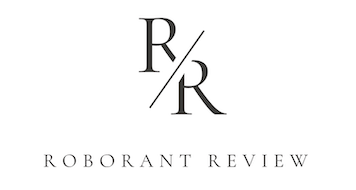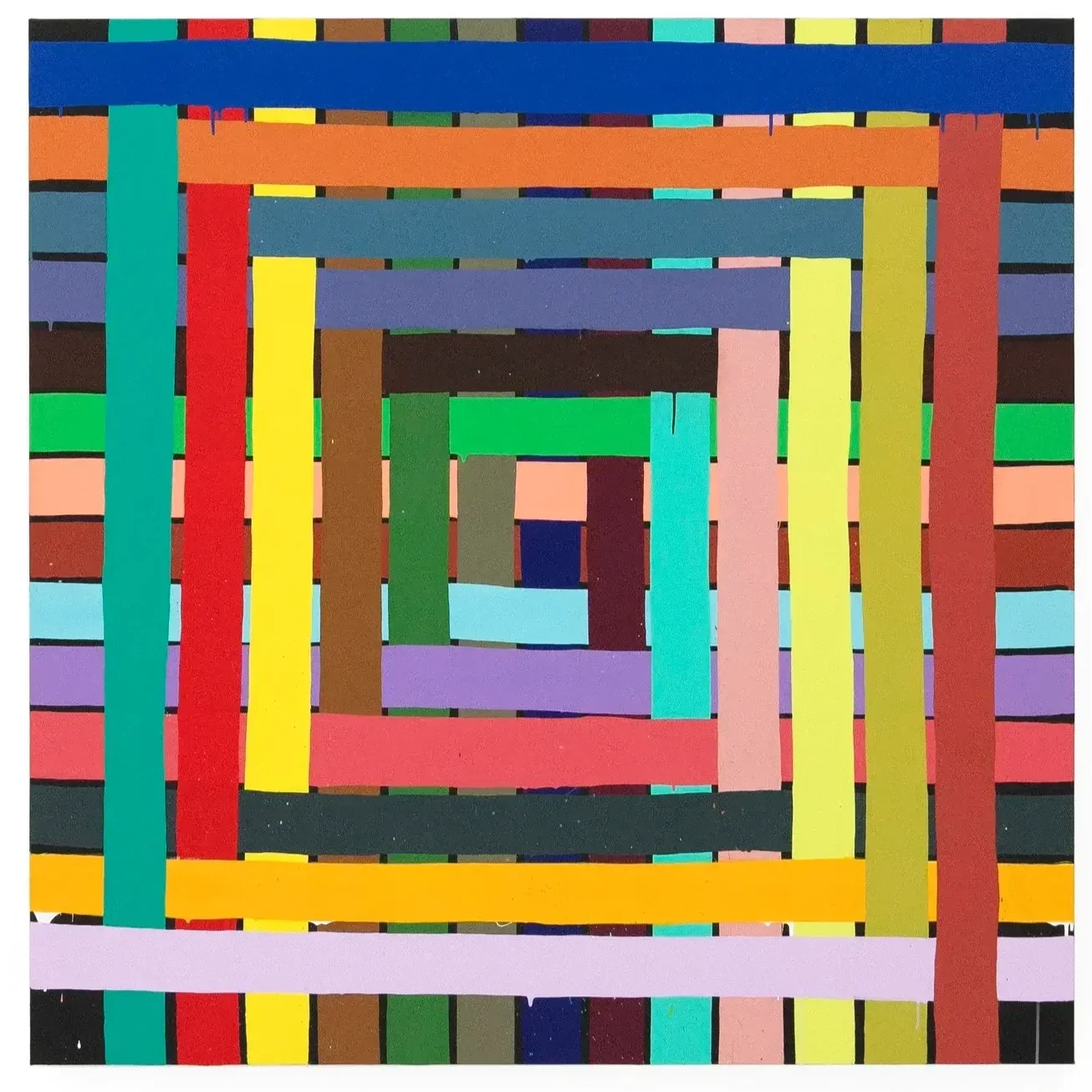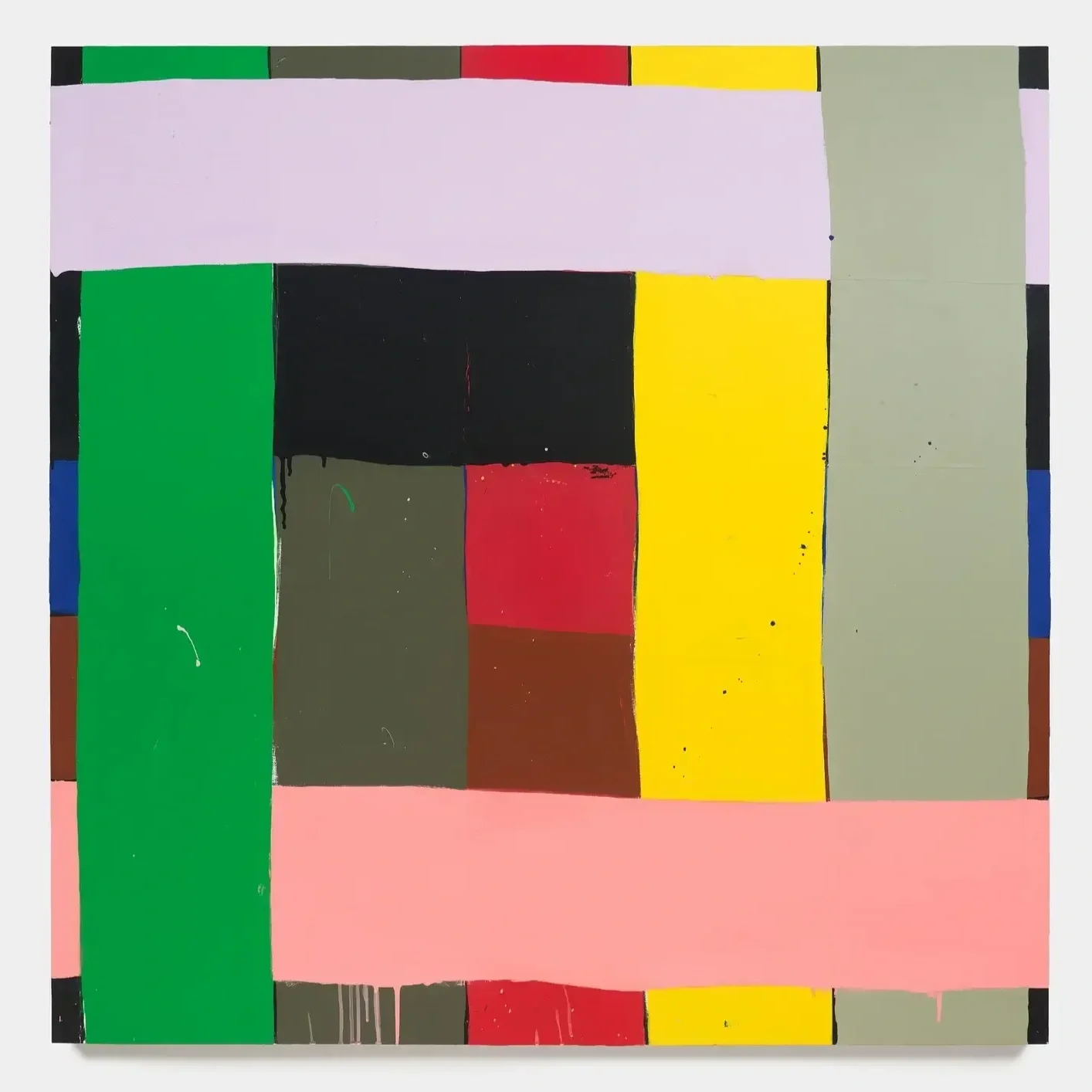Alicia McCarthy, pt.2 Gallery
By Matt Gonzalez
Alicia McCathy presents four large works on canvas and wood in her most recent exhibition at pt.2 Gallery. The paintings consist of colorful broad, partial, weave-like patterns and range in size from 48 x 48 inches to 72 x 98 inches. The medium is latex, acrylic, and flashe vinyl. Each is from a distinct year from 2022 to 2025. A number of visual properties immediately leap out toward the viewer including vibrant paint bands and a seemingly grid or labyrinth like formalism that nevertheless celebrates the imperfection of the human hand. These are not taped off hard edges, but rather slightly oblique line sequences that incorporate, and even celebrate, drip patterns. Insecurity is avoided as authenticity overrides any insistence on rigid doctrine. These are not clumsy or hesitant lines either. The boldness of wide-color swathes combine with an insolence against perfection. The lines themselves imitate movement; they animise, just as if the visual markers are breathing. McCarthy’s work poses the question of how nonobjective art can bind us, and whether there is something in how we engage these works that unifies us?
The simple design element conceals familiarity with color and form. Are we to imagine walking a maze or city block when looking at them? Architectural planning is implied. The human proclivity for order urges square arrangement of forms, or any rectangular and box-like shape, which abounds in western society; it’s how we literally plan most of our cities. Even breaks outside of geometric regularity are visually overridden by varied pigments, seemingly conjuring the manifoldness of a rainbow. These free associations speak to our cognitive process based on pattern recognition which allows individuals to register stimuli and thereafter interpret their environments. Innately related to safety and how we identify the things we know and find comfort in, the neocortex (which comprises the outer layer of the brain) is essential for visual comprehension. Looking at McCarthy’s work triggers this pattern of acknowledgment, which works constantly and instantaneously, trying to understand and bring order to what is being seen.
While the associations a viewer makes may appear wrong, or counter to McCarthy’s own intention, (because a visual clue needn’t be related to an environmental sign or its author), it nevertheless promotes emotions associated with those reflections and possibilities that therefore impact what the artwork means. These likewise must be considered generally when evaluating the impact of nonobjective art. Alicia McCarthy has said “The work is about the interconnectedness of life, how we weave in and out of things and each other. Sometimes the thread isn't consistent, sometimes it doesn't adhere to expectations, but it returns to a formal place where it remains part of the whole.” This sense of society or communion is the essence of McCarthy’s aesthetic ambit.
The paintings begin at the center, yet they feel as if there is no defined core. McCarthy mixes her paints each time she makes a long brush mark, line by line. Intuitively, she knows certain colors want to be next to one another. In Untitled (latex paint on canvas, 60 x 60 inches, 2023), the painted bands work alone and in coordination with those adjacent. One can see a cohort of simple thick lines, but the placing of strokes and selection of color gives each its own character, thus making them individual. Shades of red, brown, and green comprise the marrow of the piece. The congruent forms contain multitudes because they approximate the building of personhood, knowledge, and the friendships made. They agree with one another making a harmonious whole that defines a place and time. McCarthy’s process is the starting place for the community building often cited in her work. Both the respect for distinct color, representing the individual person; and, how it weaves and sits beside other pigments to form a unification, one could even say, a multiculturalism, are essential to conveying this quality. In some places, the long, undisputed brush mark suggests our insular being, even a solitary self, invariably coming into contact with others. The squares reference the patterns we are accustomed to seeing in quilts; or even the modernism of Josef Albers, who placed square images within other geometric square shapes. There is a primitivism in this work. Tribal patterns seem to be referenced. Although not a zig-zag chevron style design, or primitive triangle and circle scheme, they highlight something very basic and innately human.
One cannot appreciate McCarthy’s color fields without considering how the human mind responds to geometric patterns. Science has taught us that initially, visual processing occurs when light enters the cornea, pupil, and lens, which all focus and direct it onto the retina. The photoreceptor cells there convert the light patterns into electrical signals which then travel through the optic nerve to the visual cortex in the brain’s occipital lobe. That’s the mechanical explanation. Neurons in the cortex respond to colors, edges, and lines. This is where objects and shapes are recognized. It’s at this point that objects and surfaces are constructed in part because the motifs are recognized and meaning is assigned to them. All of this is happening simultaneously with other parts of the brain that work on recognizing what is being looked at, using memory to sort out how to respond.
The main takeaway is that the human brain is designed to look for patterns and symmetry whenever it processes information. There seems to be an understanding that these devices repeat and make a shortcut, allowing patterns to quickly align the visual input, thus causing faster decision-making. Additionally, it can be comforting as the eye and brain are more secure in a known setting. Viewing lines and color causes the brain to populate information and also compare with what is already in the brain’s library of possible images and meaning. McCarthy’s visual language triggers these and the most primitive associations because there are antecedent weaves and cross-hatching throughout human history. Whether intentional or not they harken to the origins of these schematics, in weaving, in object adornment, or in nature. These predictable shortcuts happen without us even thinking about it. To the extent the origins of these patterns are related to security and one's familiarity; they evoke instantaneous primal emotion through visual stimuli. McCarthy’s intention to create community or an homage related to the subcultures we build, finds its roots well before she ever created these paintings. They exist in our consciousness waiting for a prompt to reveal themselves.
A related idea is that when the composition is blemished, with natural marks or wear, the eye definitely sees this because it questions the filling-in of the adornment it found in its mental storage; the irregularity causes a momentary pause or reflection which creates a hesitation that also necessitates deeper consideration. Her reliance on detritus and accidents enhances this actualization because McCarthy celebrates apparent flaws innately knowing they precipitate a visual hiccup. The disruption of an established order is precisely what McCarthy is attempting to convey through the inclusion of these unheralded elements.
Geometric patterns have long been utilized in art works. As early as 1913, Kazimir Malevich believed color, line, and shape was paramount to subject matter or narrative storytelling. His famous Suprematist painting of 1915 featured a black square on a white background. Can geometric patterns convey narrative despite rejecting representational elements? Malevich’s book The Non-Objective World (1927) sought the primacy of pure feeling even though the architecture inherent in his work appeared decidedly formal. Piet Mondrian used straight black lines, right angles, and primary colors of red, yellow, and blue, to build compositions he believed reflected the underlying structure of the universe. While not solely relying on weave-like patterns, Malevich and Mondrian, in addition to artists such as Wassily Kandinsky (whose abstraction was more organic), explored the rhythmic and structural qualities of abstract forms, including straight lines and geometric shapes, which can be seen as echoing the underlying principles of woven patterns. Mondrian, and his De Stijl contemporaries, utilized repetition of lines and squares in their paintings to represent the underlying spiritual order of nature. McCarthy has similarly, and by semi-recurrence, created the foundation of a unique and recognizable language shared within the community she identifies with. Her legacy is equally evocative and memorable.
Weaving is one of the earliest crafts humans engaged in, thus it becomes a reference point in how we see these designs. It is believed, from evidence in the archeological record, that its existence dates to the Upper Paleolithic era, as far back as 30,000 years ago. This is incredible if you consider ancient textiles and weaving are made from organic materials. Cordage weaving, plaited basketry, and twine and woven cloth, are the basic forms that it took in its origin. The construction of woven materials, arising from the grid formed by warp and weft threads, naturally lends itself to geometric and abstract designs and has been utilized by modern artists, primarily working with textiles. In the manufacture of cloth, warp and weft are the two basic components in weaving which transform thread and yarn into textile fabrics. The vertical warp yarns are held stationary in tension on a loom (frame) while the horizontal weft (also called the woof) is drawn through (inserted over and under) the warp thread. The Bauhaus movement, particularly Anni Albers, explored the expressive potential of textiles beyond their functional purpose. Like McCarthy, Albers initially embraced the weaving medium and, through it, developed her own aesthetics exemplified by her wallhanging works of the early 1920s, insisting that there could be a harmony between use and design. Even functional textiles like draperies or simple apparel could be visual resting places that provided an antidote from the vicissitudes of our daily struggles.
The notion that geometric design can activate an innate primitivism and thus convey truths has been considered for some time, particularly as it relates to transcending cultural and geographic boundaries. The integration of weave-like patterns and principles into modern abstract painting can be said to be a natural progression of an innate human visual and tactile activity. In many indigenous communities, the way a woman weaves her hair or the textile she wears communicates where she is from and what she believes in. The symbolism is communicative. The way a woman braids her hair might tell you what village she is from, her relationship status, and her political leaning, particularly if the culture promulgates community ideas about such things. It also helps you recognize people from your own tribe. In the Hopi culture, unmarried women wore an elaborate squash blossom or butterfly whorl hairstyle. Hair was wrapped around a curved piece of wood to create two large, rounded coils on the sides of the head. This complex style marked their marital status. Many Andean indigenous communities such as the Quechua and Aymara, also use hair weave to communicate information: one braid versus two denotes specific differences in status in the community. The act of braiding with three strands often represented the mind, body, and spirit triad. Ribbons are often woven into the braids as adornment for special occasions. These unique hairstyles, often involving elaborate braids and decorated wraps, can indicate a woman's community, rank therein, or other aspects of her identity. (It should be emphasized that Two Spirit and LGBTQ+ identities thrived in pre-colonial times, so these marriage status references should be understood and contextualized within historical acceptance of wider gender-variant roles from which these enduring styles are based.)
McCarthy's work explores the visual language of abstraction, offering its potential for expression and a resulting sense of comfort and belonging. Albers and McCarthy both utilize principles such as repetition, interlocking patterns, and the interplay of color and texture, realizing they can be translated into the language of painting. Both also highlight the ways in which art can be a tool for exploring personal narratives and the boundaries within different social issues, not the least of which was the breaking of art-making boundaries. Likewise, McCarthy’s geometric patterns are uniquely discernible, thus there's a sense that we know where we are when viewing them; they comfort us, and, if part of our repertoire of images via their ubiquitousness, place us within a community of like-minded people. It may start with an aesthetic connection, but McCarthy’s weaves are not just decorative, they trigger a reference to social, and even political, ideas, thus our embracing of the resulting emotional connection pulls us in further. One can interpret viable anarchist and punk sensibilities here because the work celebrates the individual, represented by unique color marks, which break and alter edges and borders, all the while embracing a collective existence in harmony. An egalitarianism, bolstered by rejection of any authoritarianism, is also evident in the breakdown of rigid central forms in the work, thus eliminating oppressive concomitant coercion and hierarchy.
McCarthy’s patterns can certainly be read strictly as abstract patterns. But her weaves, helices (not apparent in the works included in this exhibition), and rainbows (not just the curved examples she sometimes uses in her work), extend beyond formal exercises. What might look as line and color simplicity underscores the sophistication of reducing art to its basic premise. McCarthy doesn’t need figurative elements to activate the sense of community and the individual’s role, and all their attending drama and life experiences. Rather, she does it through an ethos of how she mixes paint (individually), the substrate she often finds or prepares herself, and how she renders a straight line by hand. The latter being, perhaps, not-so-straight, yet more authentic as a result. By incorporating drips and splatters, and releasing her hand in the work, she also shares herself within these conceptually vivid paintings. The patterns tell her story, and place it within the beautifully complex moment we all share together. Interdependence and reciprocity seem always to be invited; yet all of it leaning toward freedom and the promise of self-determination.






